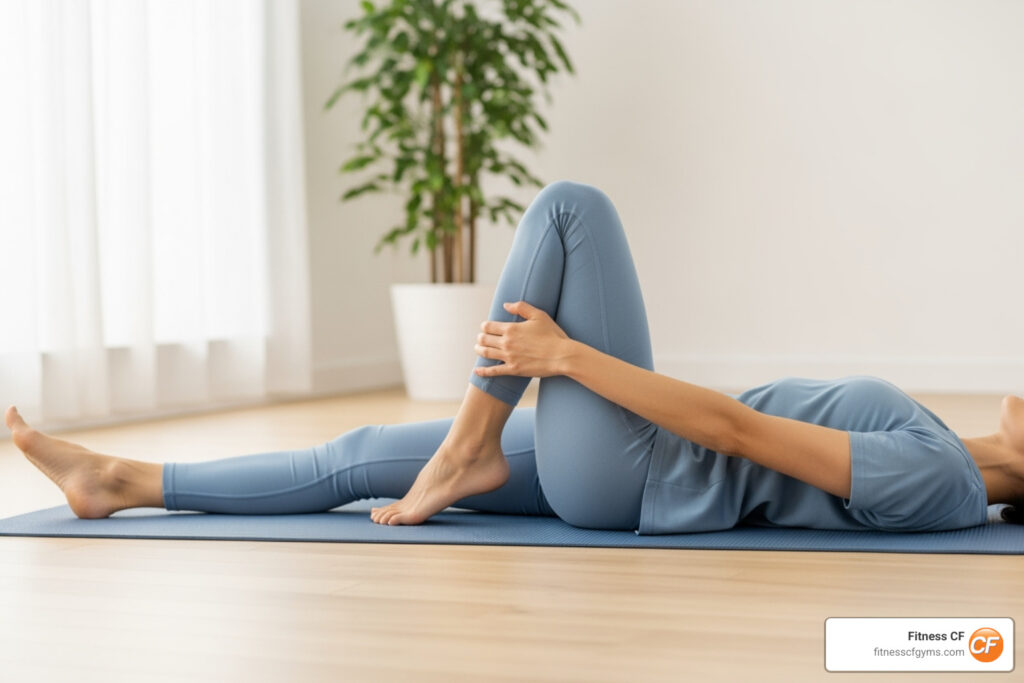Why Learning How to Work Out with Lower Back Pain Changes Everything
How to work out with lower back pain is one of the most searched fitness questions for good reason – about 4 million Americans experienced back pain in 2017-18, and roughly 70-90% of us will deal with it at some point in our lives. The good news? Exercise is actually one of the best ways to get rid of back pain and keep it from returning.
Here’s how to work out safely with lower back pain:
- Start with gentle stretches – knee-to-chest, lower back rotational stretches
- Focus on core strengthening – glute bridges, bird-dog, modified planks
- Choose low-impact cardio – walking, swimming, water aerobics
- Avoid high-risk moves – toe touches, heavy overhead lifts, twisting with weights
- Listen to your body – stop if pain increases or radiates down your leg
As physical therapist Maria Mepham notes, “Just because you have back pain does not mean you can’t go to the gym.” The key is choosing exercises that reduce range of motion while maintaining core stability.
Movement is medicine for your back. When you stay active with the right exercises, you increase blood flow to affected areas, strengthen supporting muscles, and break the cycle where pain leads to inactivity – which only makes things worse.
I’m Pleasant Lewis, and over my 40 years in the fitness industry, I’ve helped countless members learn how to work out with lower back pain safely and effectively. My experience has shown that the right exercise program can transform back pain from a limiting factor into a motivation for building lifelong strength and health.
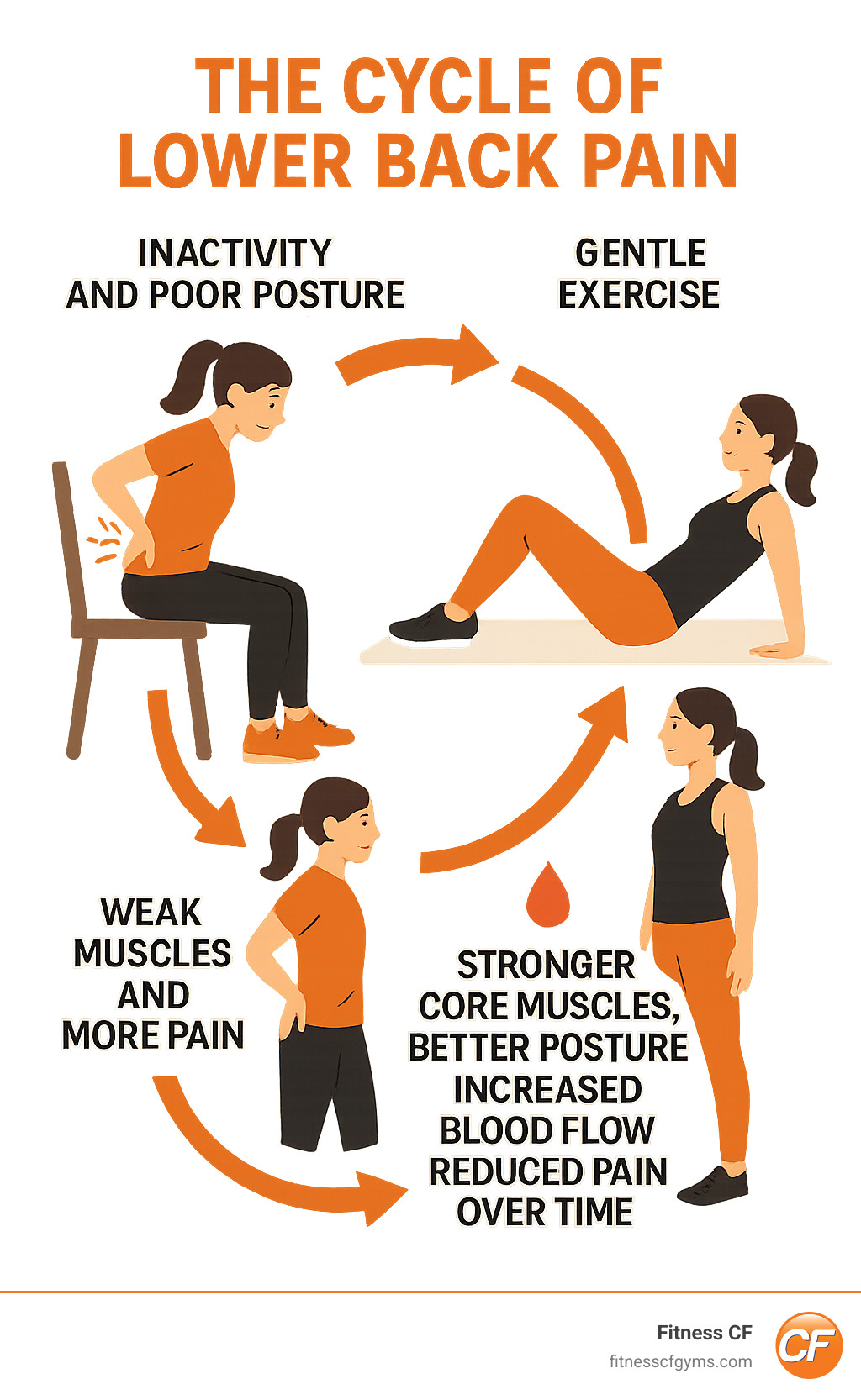
Understanding Your Lower Back Pain: Causes and When to Be Cautious
If you’ve ever winced while getting out of bed or felt that familiar ache after sitting at your desk all day, you’re definitely not alone. Low back pain is one of the most common reasons people visit the doctor, and honestly, it’s no wonder why.
The usual suspects behind your back pain are probably things you deal with every single day. Muscle strain tops the list – whether you twisted wrong while picking up your coffee mug or overdid it moving furniture last weekend. Your muscles are basically saying “hey, that was too much!”
Then there’s poor posture, which is practically unavoidable in our screen-filled world. Hunching over laptops, slouching on the couch, or standing with your shoulders rolled forward puts constant stress on your spine. Add a sedentary lifestyle to the mix, and you’ve got a recipe for trouble.
Here’s the thing that might surprise you: weak core muscles are often the real culprit behind back pain. When your abs, glutes, and deep core muscles aren’t pulling their weight, your lower back has to work overtime to keep you upright and stable. It’s like asking one person to do a four-person job – eventually, something’s going to give.
Understanding acute versus chronic pain helps you figure out your next steps. Acute pain hits suddenly and usually sticks around for a few days to a few weeks. Think of it as your body’s way of saying “let’s take it easy for a bit.” Chronic pain, on the other hand, is that persistent companion that hangs around for more than 12 weeks – this type often needs a more comprehensive approach.
When to see a doctor is crucial to know, especially when you’re learning how to work out with lower back pain. Most back pain responds well to gentle movement and self-care, but some red flag symptoms need immediate attention.
Listen to your body – if you experience radiating leg pain (especially below the knee), numbness or tingling in your legs, or weakness that makes it hard to move normally, it’s time to call your doctor. Other warning signs include changes in bowel or bladder function, unexplained weight loss, or pain that’s severe, constant, or keeps you awake at night.
The good news? Most back pain isn’t serious and responds beautifully to the right kind of movement. Understanding what’s causing your discomfort is the first step toward getting back to the activities you love – safely and confidently.
The Best Exercises for Lower Back Pain Relief
When you’re dealing with lower back pain, the right exercises can be your best friend. It might seem counterintuitive to move when you’re hurting, but how to work out with lower back pain safely can actually be one of the most powerful tools for both immediate relief and long-term prevention.
The magic happens through several mechanisms. Exercise helps your tight muscles relax and unwind, while increasing blood flow to the affected areas – think of it as delivering healing nutrients right where you need them most. At the same time, you’re strengthening the muscles that act as your spine’s natural support system and improving your flexibility for better movement patterns.
The key is finding the right balance. We recommend a three-pronged approach that combines gentle stretching for immediate relief and mobility, targeted strengthening to build a resilient foundation, and low-impact cardio for overall fitness and natural pain management. This isn’t about pushing through pain – it’s about working with your body to heal and strengthen.
Gentle Stretches for Flexibility and Mobility
Think of stretching as your daily dose of relief medicine. These movements help release the muscle tension that often builds up around your lower back, while improving your overall mobility and increasing healing blood flow to tight areas. The beauty of a consistent daily stretching routine is that it not only feels good in the moment but also helps prevent future flare-ups.
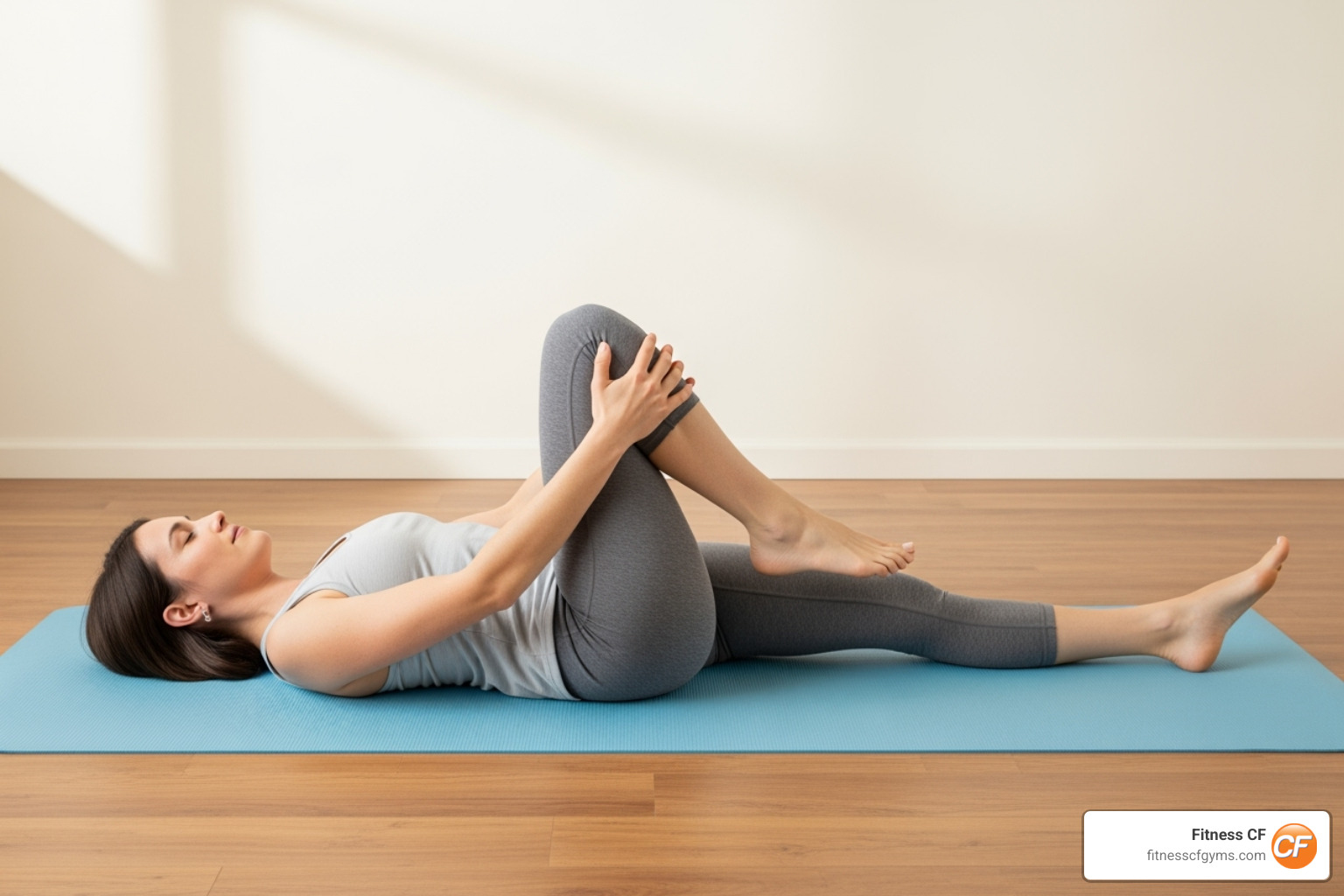
Let’s start with the Knee-to-Chest Stretch, which is as gentle as it sounds. Simply lie on your back with your knees bent and feet flat on the floor. Gently pull one knee towards your chest, holding it for 15-30 seconds while breathing deeply. Repeat with the other leg, then try both knees together. This simple movement helps elongate your lower back muscles and feels wonderfully soothing.
The Lower Back Rotational Stretch adds a gentle twist to release tension. Stay on your back with knees bent, but this time keep your shoulders flat on the floor while gently rolling both bent knees to one side. Hold for 5-10 seconds, return to center, and repeat on the other side. You’ll often feel an immediate sense of relief as tight muscles begin to let go.
Finally, the Cat-Cow Stretch brings fluid movement to your spine. Get on your hands and knees, then slowly arch your back as you inhale (letting your belly drop and lifting your head), followed by rounding your spine toward the ceiling as you exhale (tucking your chin). This gentle flowing movement helps restore natural spinal mobility and feels fantastic after a long day.
Core and Glute Strengthening for a Supportive Spine
Here’s where we build your body’s natural back brace. A strong core acts like a built-in support system for your spine, while your glutes play a crucial role in hip stability. When these muscles are weak, your lower back has to work overtime, which often leads to pain and injury.
Your deep core muscles, particularly the transverse abdominis, work like an internal corset to stabilize your spine during movement. Meanwhile, weakness in the gluteal muscles may contribute to back pain because these powerful muscles are essential for hip stability during everyday activities like walking and climbing stairs.
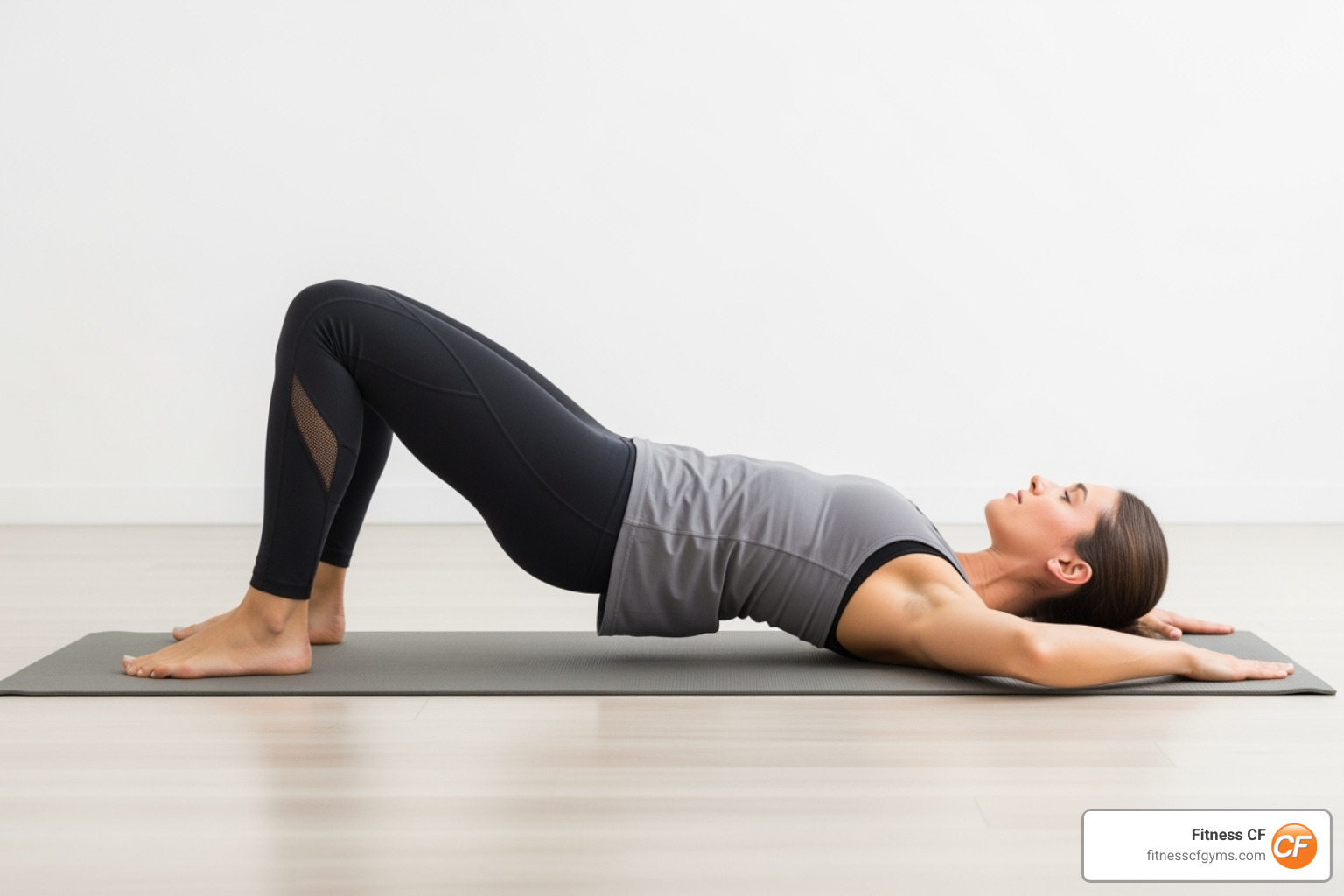
Glute Bridges are perfect for awakening those important glute muscles. Lie on your back with knees bent and feet flat, then tighten your core and glutes as you lift your hips until your body forms a straight line. Hold for three deep breaths before lowering slowly. Start with just 5 repetitions and gradually work up to 30 as you get stronger.
The Bird-Dog exercise teaches your core and back muscles to work together for stability. From hands and knees, slowly extend opposite arm and leg while keeping your back flat and hips level. This movement challenges your balance while strengthening the exact muscles you need for a healthy back. Hold for 5-10 seconds per side, aiming for 8-12 repetitions.
Modified Planks build overall core strength in a back-friendly way. Start on your forearms and keep your body in a straight line from head to heels. If this feels too challenging, simply drop your knees to the floor. Even 10-20 seconds of holding this position will start building the strength you need.
Low-Impact Cardio for Overall Fitness and Pain Management
Don’t underestimate the power of getting your heart pumping for back pain relief. Cardiovascular exercise does triple duty: it helps with weight management (less weight means less strain on your back), releases natural endorphins that act as your body’s own pain relievers, and keeps your heart healthy for overall wellbeing.
The research backs this up too. Studies show walking improves pain levels and quality of life among people with chronic low back pain. The key is choosing activities that get your blood flowing without jarring your spine.
Walking is the most accessible option and often the most effective starting point. Even a gentle 10-15 minute walk can make a difference. As you walk, engage your core by gently drawing your belly button in – this activates those deep stabilizing muscles we talked about earlier.
Swimming and water aerobics offer the ultimate low-impact workout. The water’s buoyancy reduces the load on your spine while providing gentle resistance for strengthening. Whether you’re swimming laps at a steady pace or simply walking in the water, you’re getting great exercise while being kind to your back.
Stationary cycling rounds out our cardio recommendations beautifully. Both upright and recumbent bikes can provide excellent cardiovascular benefits without excessive stress on your lower back. Just make sure your bike is properly adjusted so you can maintain a comfortable, neutral spine position throughout your workout.
The beauty of how to work out with lower back pain lies in consistency rather than intensity. These exercises work best when they become part of your regular routine, helping you build strength, flexibility, and resilience over time.
How to Work Out with Lower Back Pain: Key Principles and Moves to Avoid
Learning how to work out with lower back pain isn’t just about picking the right exercises – it’s about developing smart training habits that protect your back while building strength. The difference between helpful movement and harmful strain often comes down to proper technique, safe progression, and knowing which moves to modify or skip entirely.
Think of your workout approach as building a house. You wouldn’t start with the roof before laying a solid foundation, and the same principle applies to exercising with back pain. Every movement should serve a purpose in supporting your spine’s health and stability.
The “Dos”: Proper Form and Consistency for how to work out with lower back pain
The foundation of safe exercise with lower back pain starts with proper posture and maintaining a neutral spine. This means keeping your back in its natural alignment – not excessively arched like you’re trying to show off your chest, and not rounded like you’re slouching over your phone. Your spine has natural curves, and we want to honor those during movement.
Core engagement is your secret weapon. Think of gently drawing your belly button toward your spine, like you’re bracing for a friendly poke in the stomach. This isn’t about sucking in your gut dramatically – it’s about creating a stable foundation that supports your back during any activity.
Don’t underestimate the power of proper breathing techniques. Many people hold their breath during exercise, which creates unnecessary tension. Instead, breathe naturally and rhythmically. Generally, exhale during the exertion phase of an exercise and inhale during the release.
Warm-up and cool-down aren’t optional extras – they’re essential bookends to your workout. Spend 5-10 minutes with gentle movement like walking or marching in place to prepare your muscles. After your workout, dedicate time to gentle stretching and deep breathing to help your body transition back to rest.
Gradual progression is where patience pays off. Start with fewer repetitions and lighter resistance, then slowly increase as your body adapts. Your back didn’t develop pain overnight, and it won’t heal overnight either. Consistency trumps intensity every time.
The magic happens when you make exercise a regular habit. Studies show that people with back pain who stick to a consistent exercise program experience less pain and return to their normal activities more successfully than those who exercise sporadically.
The “Don’ts”: Exercises to Modify or Avoid when you work out with lower back pain
While movement is medicine for your back, not all movements are created equal. Some exercises can be like poking a bear – they might seem harmless but can quickly escalate your pain. The golden rule is simple: stop immediately if you feel sharp, shooting pain during any exercise.
High-impact activities like running on concrete or intense jumping exercises can jar your spine like a car hitting potholes. Your discs and joints need gentler treatment while they’re healing. Abrupt twisting motions, especially while holding weights, put your lumbar spine in a vulnerable position since it’s not designed for much rotation.
Those old-school toe touches with straight legs that we used to do in gym class? They’re particularly problematic because they put excessive strain on your lower back and hamstrings simultaneously. Heavy overhead lifts or exercises where weight rests on your shoulders can compress your spine or force an unnatural arch in your back.
The good news is that for every risky exercise, there’s usually a back-friendly alternative that gives you similar benefits without the danger.
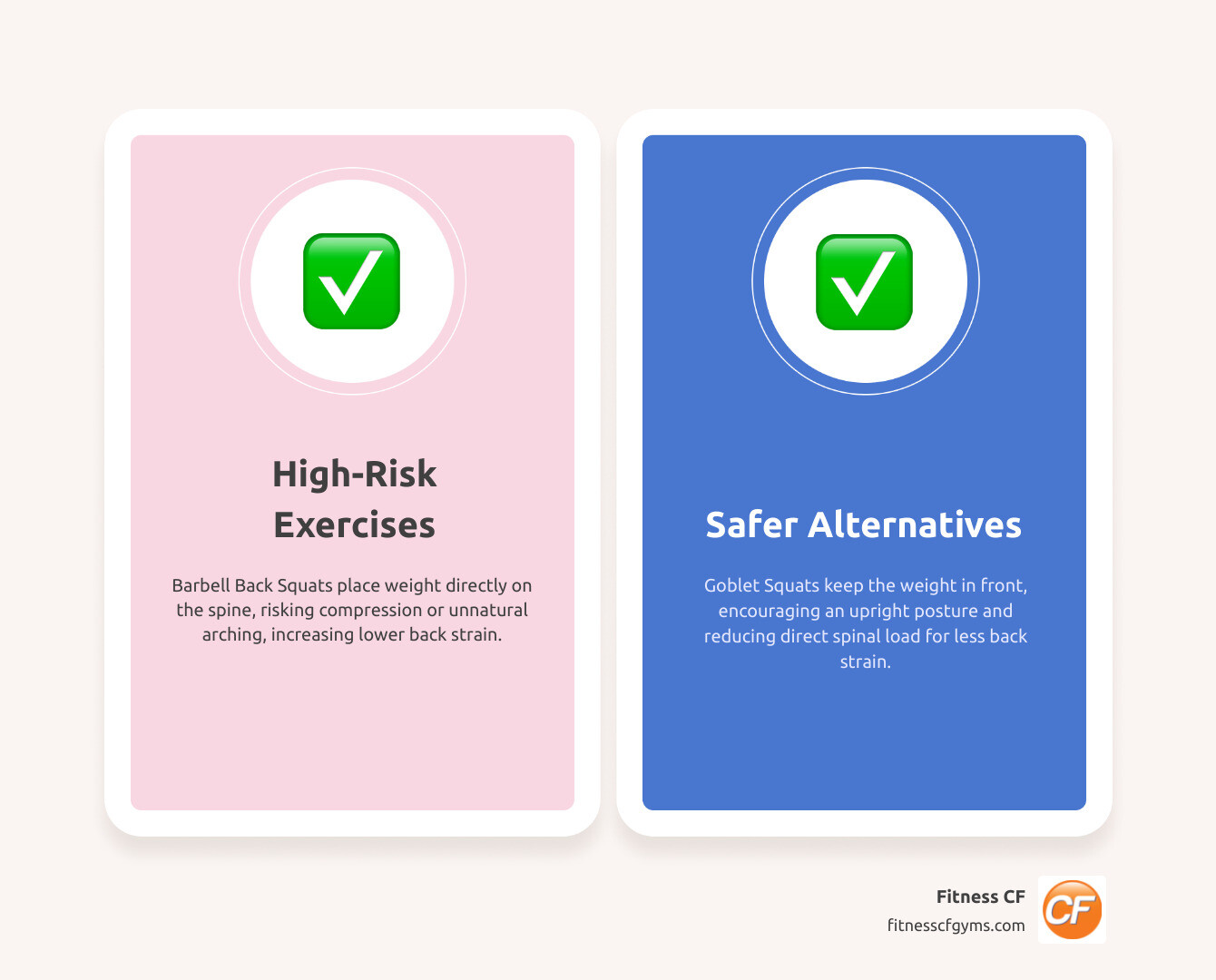
| High-Risk Exercise (Avoid or Modify) | Safer, Back-Friendly Alternative | Why the Alternative is Better |
|---|---|---|
| Barbell Back Squat | Goblet Squat | The weight is held in front, which helps keep your torso more upright and reduces strain on the lower back. |
| Traditional Deadlift | Lifted Kettlebell Deadlift or Trap Bar Deadlift | Reduces the range of motion and keeps the weight closer to your body’s center, minimizing lower back stress. |
| Full Sit-ups / Crunches (with straight legs) | Partial Curls or Modified Plank | Partial curls protect the neck and lower back, while planks build core stability without spinal flexion. |
| Bent-Over Barbell Rows | Chest-Supported Rows (on a bench) | Eliminates lower back involvement by supporting your torso, allowing you to focus on back muscles without spinal strain. |
| Overhead Barbell Press (Standing) | Kneeling Scrape the Rack Press or Seated Dumbbell Shoulder Press | Reduces the tendency to arch the lower back and provides more stability, especially the kneeling version. |
| Toe Touches (with straight legs) | Knee-to-Chest Stretch or Hamstring Stretch (with bent knee) | Directly targets hamstring flexibility without putting undue stress on the lumbar spine. |
| High-Impact Running/Jumping | Walking, Swimming, Elliptical Trainer, Stationary Bike | Provides cardiovascular benefits without the jarring impact on spinal discs and joints. |
The goal isn’t to avoid exercise altogether – it’s to build strength and stability without aggravating your pain. Trust your body’s signals. If an exercise feels wrong or causes your pain to spike, it probably isn’t right for you at this moment. There’s always another way to work toward your fitness goals while respecting your body’s current limitations.
Frequently Asked Questions about Exercising with Back Pain
When it comes to how to work out with lower back pain, we hear the same concerns from people time and time again. These are completely natural questions – after all, when your back hurts, the idea of exercising can feel intimidating or even counterintuitive. Let’s address the most common worries and clear up some misconceptions.
How can I make my lower back stronger?
Building a stronger lower back isn’t just about targeting those specific muscles – it’s about creating a supportive network throughout your entire core. Think of your body like a house: you can’t have a strong roof without solid walls and a good foundation.
Focus on compound movements that engage multiple muscle groups working together. These mirror real-life activities and build functional strength. Core exercises like planks and bird-dogs create that natural corset effect around your spine. Glute strengthening through bridges and similar moves helps stabilize your hips and takes pressure off your lower back. Don’t forget your back extensors – these muscles help you stand tall and maintain good posture throughout the day.
Here’s the thing: consistency beats intensity every single time, especially when you’re starting out. It’s better to do gentle exercises regularly than to go all-out once a week and end up sore. Proper form is absolutely critical – it’s not about how many repetitions you can do, but about doing each one correctly to avoid injury and maximize the benefits.
Should I stop exercising completely if my back hurts?
This might surprise you, but if you think treating back pain means heading straight to bed and staying there, you’re actually making things worse! Complete rest is counterproductive for most back pain situations. Your muscles need movement to stay healthy and promote healing blood flow to the affected areas.
That said, we’re not suggesting you ignore your body’s signals. Listen to your body – if you feel sharp, shooting pains or pain that radiates down your leg, stop immediately. But for general lower back discomfort, gentle movement is medicine.
Modify your routine rather than abandoning it entirely. Switch to low-impact cardio like walking or swimming. Gentle stretching can provide relief and keep your muscles from getting stiff. The goal is to stay active within your comfort zone, promoting healing without causing additional damage.
Bed rest is actually counterproductive for most back pain. Movement helps prevent your muscles from weakening further and keeps your joints mobile.
How long does it take for exercise to help my back pain?
The timeline for relief varies depending on what type of exercise you’re doing and how consistent you are with it. Stretching can provide immediate relief from muscle tension – you might feel better right after a gentle stretching session, though this relief may be temporary at first.
Strengthening takes weeks to show real results. Your muscles need time to adapt and grow stronger. Most people start noticing improvements in their pain levels after 2-4 weeks of consistent strengthening exercises. But here’s the key word: consistent.
This is a long-term commitment, not a quick fix. We like to think of exercise for back pain as a lifestyle change rather than just a treatment. The real goal is prevention – building a resilient back that can handle whatever life throws at it.
Focus on the process, not just the outcome. Each day you move your body and strengthen your core, you’re investing in a healthier, more pain-free future. The benefits compound over time, creating lasting changes that go far beyond just pain relief.
Conclusion: Building a Resilient Back for a Healthier Life
Learning how to work out with lower back pain isn’t just about managing discomfort – it’s about changing your entire relationship with movement and health. Movement truly is medicine for your back, and the journey you’ve started by choosing exercise over inactivity is one of the most powerful decisions you can make for your long-term well-being.
The beauty of taking a proactive approach to your back health lies in how it ripples out into every area of your life. When you commit to gentle stretching, core strengthening, and low-impact cardio, you’re not just addressing pain – you’re building cardiovascular health, improving your mood through natural endorphin release, and creating habits that support a lifetime of vitality.
Listen to your body as you continue this journey. Some days you’ll feel amazing after your glute bridges and walking routine. Other days, you might need to scale back to gentle stretches and that’s perfectly okay. The key is consistency, not perfection. Celebrate every small victory – whether it’s holding a plank for an extra five seconds or walking an additional block without discomfort.
Building long-term back health means understanding that this isn’t a quick fix, but rather a lifestyle change that pays dividends for years to come. The strength training exercises we’ve discussed don’t just support your spine – they boost your metabolism, improve bone density, and improve your overall functional fitness. The cardio activities help maintain a healthy weight, reducing strain on your back while supporting heart health.
At Fitness CF, we believe in building a strong foundation for a lifetime of health. Our focus is on empowering you to live an active, pain-free life through comprehensive fitness and wellness strategies that grow with you over time.
Post-workout recovery is just as important as the exercises themselves. Your muscles need time to repair and strengthen between sessions. Consider exploring recovery amenities like Hydromassage to soothe sore muscles as part of your complete wellness routine.
Your back pain doesn’t have to define your fitness journey. With the right approach, patience, and commitment to movement, you’re building not just a resilient back, but a healthier, more vibrant life ahead.

